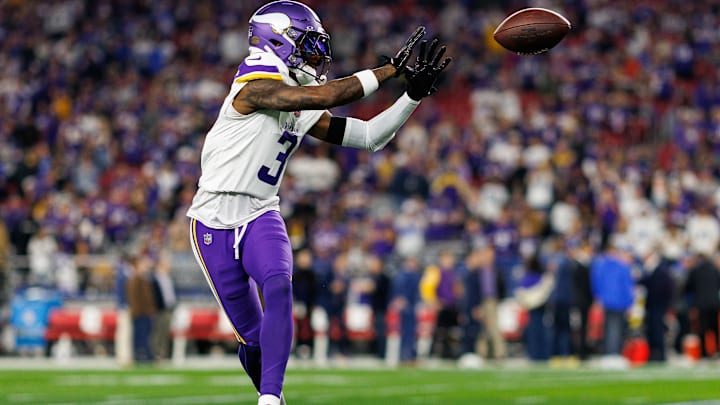Across the board, Jordan Addison's numbers dropped off from his rookie season to last year. But he also missed two games and a big chunk of another due to an ankle injury, and if he had been healthy for every game his numbers would have projected close to what he did as a rookie.
Addison has proven himself to be a worthy No. 2 wide receiver to Justin Jefferson, and a key piece of the Minnesota Vikings' offense. His 19 receiving touchdowns over the last two seasons are tied for fourth-most in the league over the span.
It's often said the biggest jump an NFL player makes is from his rookie season to his second year. Addison obviously did not make a big statistical leap in his second season, but his Pro Football Focus grades were a bit better year-over-year and improvement of that kind should not be discounted.
There were some areas where Addison took a big step last season.
Analyst highlights areas of big improvement for Minnesota Vikings wide receiver Jordan Addison in 2024
Matt Harmon of Yahoo! Sports is also the founder of "Reception Perception", which tracks the success (or lack thereof) receivers have when running certain routes across the entire route tree, against certain coverages, etc. He recently took a look at Addison, and noted some areas he really improved in compared to his rookie season with the Minnesota Vikings.
"While Addison’s success rate vs. zone coverage was in the same neighborhood of his rookie season, he made significant strides against man and press. He jumped from 63% success rate vs. man to a strong 70.9% in Year 2 and went from a poor 51.5% success rate vs. press up to a respectable 66%. Addison still isn’t a perfect separator and can get stuck at the break point of routes a little too often but that type of improvement is something we love to see. You can hold down a long-time starting gig as an outside receiver if you hover around a 70.9% success rate vs. man coverage."
Press coverage is a common thing for rookie NFL wide receivers to struggle with. Overall, college corners just can't do it like NFL corners can. Without broader context, a 7.9 percent success rate increase against man coverage and a 14.5 percent increase in success rate against press coverage land as uniquely large year-to-year jumps.
Harmon then dove into another area Addison showed marked improvement in from Year 1 to Year 2.
"Another big area of improvement for Addison in his second season came at the catch point. He dropped just one pass overall in this sample but more importantly, he was excellent in tight coverage. Addison saw a contested target on just 13.6% of his sampled looks but won 87.5% of them. He checked in at 50% in his rookie season, so that was a big jump."
"It was closer to his 78% contested catch rate from his prospect profile. Addison clearly put in the work to get stronger at the catch point and he rarely let defensive backs disrupt his timing. He had vice grips in 2024 and was just one of the best catchers of the football, regardless of the situation."
Addison doesn't have the kind of size we associate with receivers who are contested catch/red zone mavens, nor does he easily overwhelm defensive backs with sheer speed as a downfield threat. So he has to win in margins, like vs. man coverage, vs. physical press coverage and catching the ball more often than not when coverage is tight on him. The notable improvement he showed in all three areas last season, with some room to improve there and elsewhere, might change Harmon's bottom line in short order.
"There are still some limitations in his game that keep me from ranking him among the best No. 2 wide receivers in the league. There’s a step down from the DeVonta Smith and Tee Higgins types of the world to where Addison ranks.“
